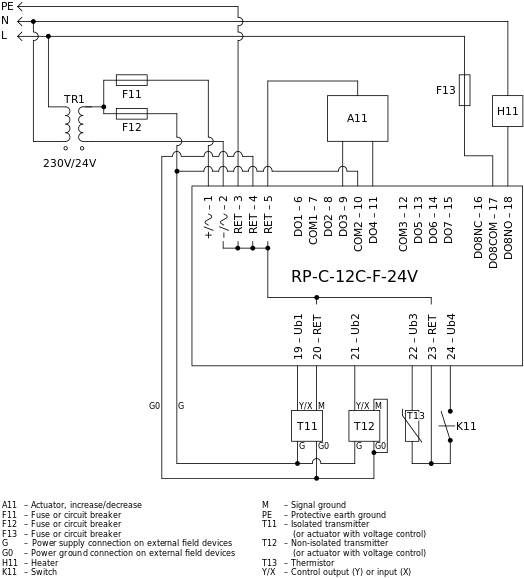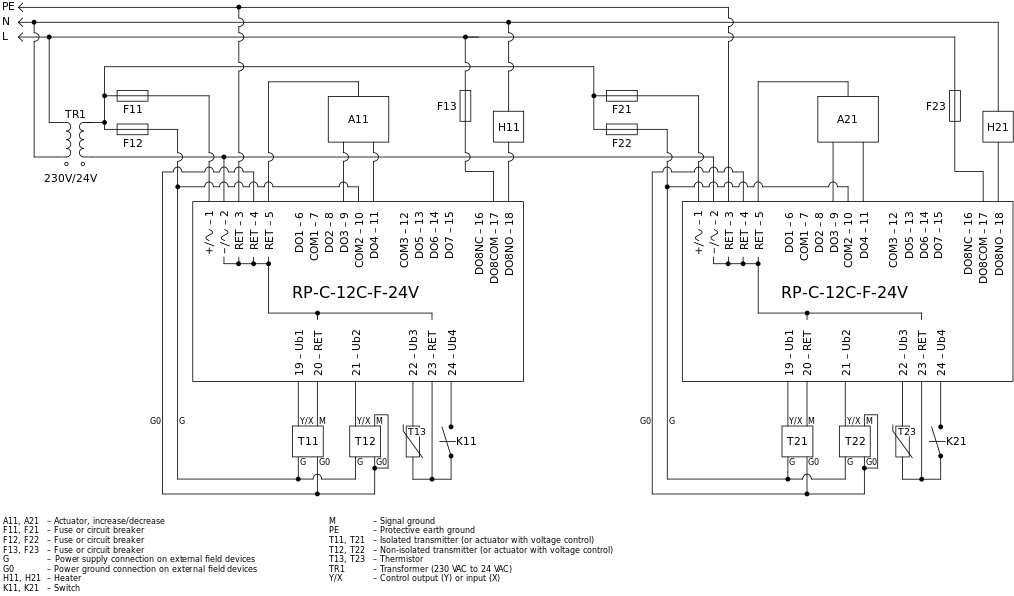
Concept
Grounding and Power for Systems with RP-C 24 V Controller Models
This section provides grounding and power recommendations for system configurations with the RP-C controller models that support 24 VAC/DC input power.
For more information, see RP-C Models .
You can use one local transformer for each RP-C controller (with its connected devices) to minimize any problems with ground loops and disturbances.
Use the following recommendations to design a good working system:
Select any of terminals 4 or 5 to be used as G0 (Power Ground/Common).
G0 (terminal 4 or 5) can be connected to RET. Avoid this if not necessary.
The fuse (circuit breaker) F11 must be rated 3 A or higher.
Signal Ground Rail (SGR) is not needed.

System configuration with an RP-C 24 V controller model powered by a local transformer
The fuses F11 and F12 may be combined into a single fuse (circuit breaker).
It is important to know that several nodes are internally interconnected to the common signal ground. This is important for safety reasons and to help avoid ground loops and incorrect supply of G0. The following nodes are all interconnected:
All RET terminals (4, 5, 20, 23, 26, and 29)
Antenna connector
USB connector shields
Ethernet network connector shields
RS-485 (Room bus and Sensor bus) ground reference
Terminal 2 (N/G0 input)
In case several RP-Cs are supplied from one common 24 V transformer, terminal 2 is interconnecting all internal grounds for all RP-Cs.
Powering more than one RP-C controller from a common transformer is acceptable when the controllers are installed within the same cabinet, or directly adjacent cabinets connected with conduit.
Use the following recommendations to design a good working system:
Use the same recommendations regarding G0, terminals 4 and 5, and fuse (circuit breaker) ratings, as provided for a system with a local transformer above.
Do not interconnect the RP-C controllers and their groups of connected devices, such as actuators and transmitters, beyond what is shown in the figure below to minimize potential problems with ground loops.
It is recommended to use separate fuses (circuit breakers), F11 and F21, for the power supply to each RP-C controller so that a problem with one RP-C controller does not affect another RP-C controller.
If you use a common fuse (circuit breaker) for two RP-C controllers, and there is a problem with one of the controllers, the troubleshooting may be more difficult than if there is a problem only with one actuator or transmitter.
It is recommended to use separate fuses (circuit breakers), F12 and F22, for the power supply to actuators and transmitters connected to different RP-C controllers so that a problem with an actuator or transmitter connected to one RP-C controller does not affect an actuator or transmitter connected to another RP-C controller.
It is recommended to use separate fuses (circuit breakers), F13 and F23, for the power supply to heaters connected to different RP-C controllers so that a problem with a heater connected to one RP-C controller does not affect a heater connected to another RP-C controller.

System configuration with two RP-C 24V controller models powered by a common transformer
 I/O Wiring
I/O Wiring
 Grounding and Power
Grounding and Power
 RP-C Controllers
RP-C Controllers
 RP-C Models
RP-C Models